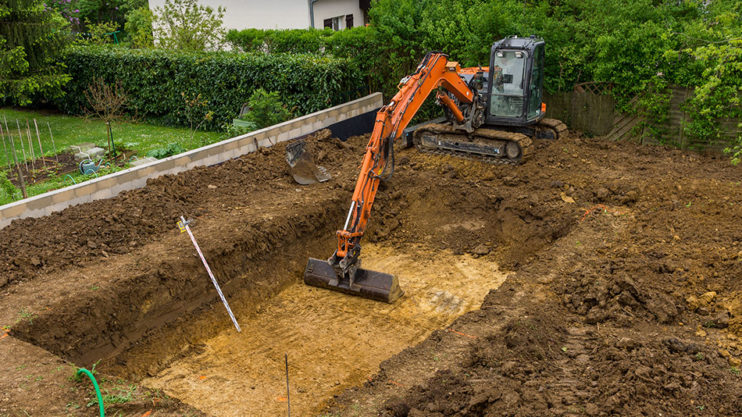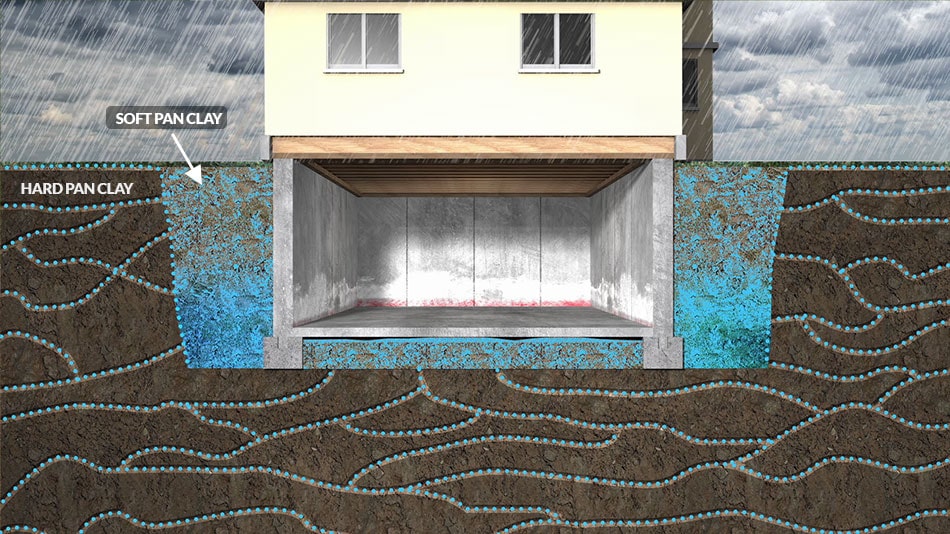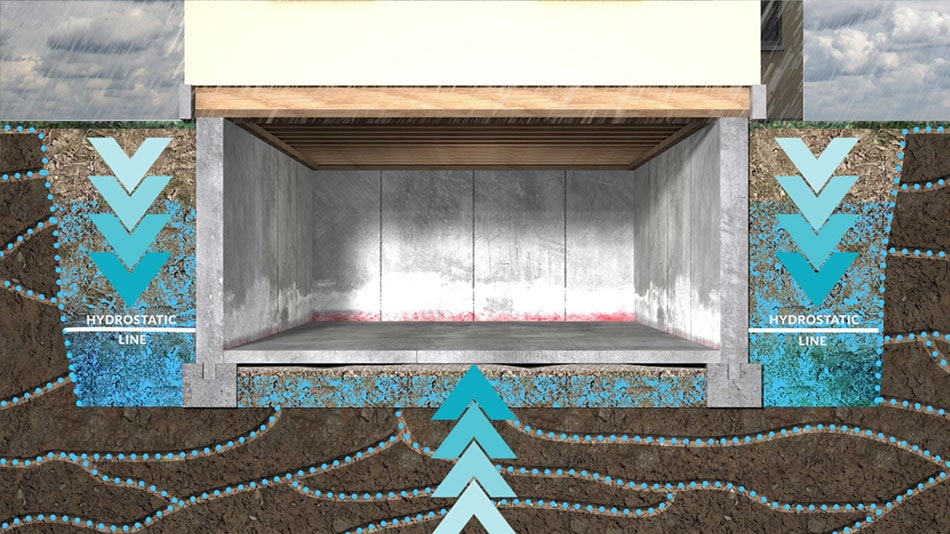Wet Basement Problem: False Water Table

Share this Post
A false water table is the primary cause of wet basements, deteriorating foundation walls, and cracked floors. It is “false” because it is temporary. It lasts for ten days to two weeks, and it is weather-driven.
When you get heavy rain, the backfill area outside your foundation walls fills up with water. Why does it fill with water?
Table of Contents
Creating a Place for a False Water Table
When they first built your house, an area of approximately eight feet was empty around the entire foundation outside your walls. Then they take the dirt dug out of the ground to build your foundation and backfill the open space. Backfill has been rolled over, bulldozed, and piled up. It loses a lot of its density.
They tamp it down when they put that backfill around your entire foundation. It will never get as dense as the undisturbed soil called “hardpan clay.” We like to call the backfill soil “soft pan clay.”

Hardpan clay does not absorb water all that well. Water will go down into it when it rains and travel through the hardpan clay using a network of capillaries formed over many years. All the water traveling through the hardpan clay will dump into the soft pan clay surrounding your house. It will saturate and fill that confined area as it increases. The higher it goes, the more pressure it creates with the weight of the water. Your foundation walls will attempt to sustain the full force of “hydrostatic pressure.”
Importance of a Strong Basement Floor
The slab floor plays a significant role in sustaining the dangerous pressure outside your walls. It is imperative to keep your floor intact, with a minimum of 3.5-inch thickness, and up against the walls. Many waterproofing companies, and fly-by-night contractors, compromise the structural strength by completely removing the floor from the wall. They never return it to a code-compliant thickness or keep some of the original floor against the walls. They have removed the floor’s support from the walls, which can lead to cracking.
Why Do Basement Floors Crack?
The other thing a false water table does as it gets higher; the water forces its way down into the ground and comes up underneath the floor. It can produce cracks in your floor. Most people think the cracks are caused by settling. It is not settling. It is hydrostatic pressure that has pushed up and cracked that floor.
98% of the time, the whole reason why you have a water issue in your basement is because of a false water table on the outside of your walls. If you install a shallow, narrow gutter or box drainage system, you will not be able to speed up the dropping of your false water table.

If you get the correct drainage, you can drop the false water table quickly, eliminating stress on your walls and beneath your floor. The water pressure will never get a chance to happen.
Effects of Acidic Groundwater
Concrete is porous. The waterproofing on the outside of your foundation walls, applied during construction, usually deteriorates in 3, 4, or 5 years, after which it will allow water to get absorbed into your walls. When water is absorbed from your backfill area, it absorbs some of the soil in with it. Dirt in the northeast is notorious for having an acidic quality. Concrete is made of sand, stone, and lime. Lime is the glue that holds it together. Lime and acid are on opposite ends of the PH scale.
The white powder you see forming on your basement walls is the lime leeched out of your concrete wall. That white powder is called efflorescence. The quicker you remove that false water table outside your basement walls and underneath your floor, the less stress is on your foundation. If you can control the false water table, you can slow down your whole foundation’s aging process.
Choosing a Basement Waterproofing System
The waterproofing system you install has a lot to do with the entire aging process of your whole house. If your foundation walls move, they will crack a bit. Your home will twist, turn, and resettle to a new position. It causes warp flooring, windows can get out of alignment, and even your walls can pull from the roof. Moisture can get in and cause problems in your attic. Many people don’t realize that a roof problem usually starts in the basement from movement in the foundation.
Choosing the right basement waterproofing system for your particular type of water problem.
Choose a system that will:
- Remove water quickly enough to keep the hydrostatic level low.
- Do not compromise the structural integrity of your foundation.
- Return a code-compliant floor thickness of the concrete to your basement.
- Only a company confident in their work will give a lifetime transferrable warranty.
Schedule a free, no-obligation inspection and quote at no cost.